The Intermediate Chinese Pantry
Six months ago, I wrote a post entitled “Staple Ingredients of the Chinese Pantry” where I listed the basic must have goodies for a budding Chinese cook. And the post was a great success, and it helped a lot of folks out and almost immediately, readers were asking for a follow-up on what to buy next.
Well, finally, here is the post that lots of folks have been waiting patiently for, and emailing me about, and I really hope you all find it as helpful as the first one–remember that this list is my own personal opinion on where you can go next in your explorations of Chinese cookery. Adding these ingredients will allow you to make some really great regional classics of Sichuan, Canton and Hunan, and will broaden your tastes a little. These ingredients will give you plenty of new flavors, fragrances and textures to experiment with while you come up with some of your own recipes.
And while you are at the Chinese market, you are going to see lots of other ingredients that I haven’t listed here. Stuff that you may not recognize, but which looks intriguing to you.
Things such as kekap manis–a thick, sweet soy sauce from Indonesia. Or, fermented “stinky” tofu packed in jars with chile paste.
By all means, let me encourage you, that if you have the money, the inclination and the pantry space, to pick up whatever items appeal to you, and experiment. In truth, that is how I have come by most of my knowledge of Asian ingredients: I go to the market, I see something I either don’t recognize, or have only read about in books, pick it up, buy it, take it home and try it out. Some of them, like kimchee, have become fixtures in my kitchen, while others, like the fermented tofu, have been banned forever by Zak and Morganna, who cannot abide the smell. (Whereas I rather liked it.)
I suspect that all of you understand that most of these items are not available in American grocery stores. You are going to have to visit an Asian market or order online for these ingredients. And that is fine–even if there isn’t a market close to you, save your shopping for the next time you take a road trip to the closest big city. Take the list with you, and make an event of your shopping expedition. Have an adventure–it is fun!
Sichuan Peppercorns: These are the tiny dried pods of the fruit of trees of the genus Zanthoxylum, known in English as the mountain ash or prickly ash. These dark russet to brown little pods look vaguely like opened flower buds, and are piquant, with a chilly, numbing quality that is prized among Chinese chefs and home cooks, particularly those of Sichuan province. Known in Chinese as huajiao, Sichuan peppercorns, are also a component of Chinese five spice powder.
They are used whole in soups and long-braised dishes, such as Sichuan beef with turnips, and ground, in Kung Pao Chicken. I have even used them ground up in cookies to amazing effect. If you do not have an Asian market near you, you can order them online at Penzey’s; I keep mine in the freezer, triple wrapped, for maximum freshness, and only grind them right before using them. I also find that toasting them briefly in a small cast iron skillet before grinding them brings out the greatest flavor. For more information on Sichuan Peppercorns, see a previous post on the subject.
Star Anise: This beautiful star-shaped spice is the pericarp of a small evergreen tree native to China. Star anise, known in Chinese as bajiao, lends its sweet, licorice-like flavor to five-spice powder. It is essential in braised dishes such as Red Cooked Pork with Taro and Sweet Potato. In fact, if you want to make any Chinese braised dishes at all, I would highly suggest getting some star anise, as its flavor is a necessity in those types of dishes, particularly the ones containing red meats such as pork, beef and lamb. It is also useful in Indian cookery, and it is very good brewed with oolong teas; when I have a cold, I like to make a tea with oolong, Sichuan peppercorns, stick cinnamon, cardamom and star anise.
I keep mine in the freezer in order to keep them at maximum flavor and freshness. They are sold in little cellophane packets in the spice and dried foods section of most Asian markets, but if you do not have one near you, once again, you can order these from Penzey’s.
Chili Bean Paste/Sauce: This is an essential ingredient for Sichuanese cookery. Made with fermented soy and broad beans, wheat, salt and chilies, this salty, spicy, dark red condiment is filled with delicious umami flavor, and is the ingredient that gives Sichuan red-cooked meats (such as Beef with Turnips) and Ma Po Tofu its intensity and fragrance. The best brands are actually made fully with broad beans and include the words, “broad bean” on the label. Chili black bean sauce is not the same thing; the flavor profile is completely different and it would never give the correct Sichuanese flavor to the dishes meant to be made with true Sichuanese broad bean chili paste.
My favorite brand that is easily fround in most Asian markets around here is made in Taiwan by Ming Teh Food Industry. The two jars pictured on the left above are both from Ming Teh–they just recently changed their label. The one on the far left is the older label, and the one in the middle is the newer one. They both contain the same sauce: very thick, with a somewhat liquid paste-like consistency, deep red and pungent with a few lumps of intact broad bean left. It is quite spicy, and only moderately salty, with a hefty dose of umami savoriness that gives many Sichuanese recipes their unique character.
Lee Kum Kee makes a version of this sauce which is passable. It is saltier than I would like and not as complex in flavor, but it is acceptable. It is also quite easily found not only in Asian markets but in some American grocery stores as well.
I store this sauce in my refrigerator after it is opened, and it keeps forever. The amount of salt, lactic acid from the fermented beans and chilies pretty much keep all harmful bacteria at bay.
Tianjin Preserved Vegetables and/or Sichuan Preserved Vegetables (Zha cai): I generally have both of these in my kitchen at any given time, however, presently, I only have the Tianjin preserved vegetables from the Tianjin Leiching Pickle Company. They are different, but the flavor profile is similar enough that I have found I can use them in many recipes interchangeably. The Tianjin vegetable is basically a pickled Chinese cabbage made with the lactic acid fermentation process. Garlic is generally added to the pickling mixture, and this gives the cabbage, which has a distinctive crunch, a hauntingly robust flavor. It is used to flavor soups, braised dishes, noodle dishes and stir fries.
The brand that I buy from the company mentioned above comes packed in the beautiful round earthenware crock you can see in the photograph at the beginning of this post.
I just keep it in its crock, sealed tightly with its own plastic cap, in the refrigerator and I have never had anything go awry with it, no matter how long I keep it. Salt-preserved fermented vegetables will keep nearly forever so long as you use a clean utensil to get some out of the crock before sealing it back up again. (Dirty fingers are a no-no.)
Sichuan Preserved vegetable, also known as Zha cai, is the pickled stem of mustard greens. Like the Tianjin preserved vegetable, this is a salted pickle, preserved with a lactic acid fermentation, but instead of being flavored with garlic, the Sichuan version is flavored with a great deal of ground chili pepper.
Before using the Sichuan preserved vegetable, it is best to rinse off the excess salt and chili, then drain it or pat it dry with a towel. Zha cai adds flavor to Sichuan dry fried green beans, and is delicious cooked with noodles or in a stir fry with pork or tofu. It is great in hot and sour soup, too.
The brand that I usually buy, Ma Ling, comes in a can with a red and yellow label. After opening it, I usually put the remainder that I do not use right away into a glass jar and keep it tightly sealed in the fridge.
Pressed Spiced Tofu/Spiced Dry Tofu: Known as either pressed spiced tofu or spiced dry tofu, this is one of my favorite styles of bean curd to use in Chinese or Thai cookery. It is very firm, having had almost all of the water in the product pressed out, after it has been marinated in a spiced liquid. The resulting low-fat protein source is pale tan on the inside and reddish brown on the outside, and has a chewy, meaty texture that is uniquely smooth and quite pleasant. Cut into thin shreds it can be used marinated in noodle salads, cut into very thin strips, it can be stir fried or dry fried until it curls into crisp-chewy petals. Cut into medium thin to thick strips, it can be stir fried or braised.
The brand I use, pictured above, is made by Water Lilies Foods, and the purple, orange or green packages are available in the refrigerated section of most Chinese markets. The different colors on the packets denote different thicknesses of the tofu blocks. Left in its vacuum-sealed package, it lasts quite a long time-just look for the “use by” date stamped on it. Once it is opened, if you have any leftovers, they can be sealed in a ziploc bag for only a few days before it starts to go off.
I use this tofu all the time, and have some in my fridge for a quick stir fry on the spur of the moment, when I have no idea what else to do with it. One of the best dishes using spiced dry tofu as a main ingredient is Spicy Pork With Pressed Beancurd Stir Fry, which I learned from House of Hunan, an excellent restaurant in Columbia, Maryland.
Rock Sugar: Rock sugar, also known as crystal rock sugar or rock candy, is made from a solution of white sugar, brown sugar, honey and water, brought to a boil. The syrup is allowed to crystallize, and it forms beautiful lumps of yellowish sugar candy which look rather like rough citrine gemstones. Rock sugar is used as a flavoring agent in braised dishes, primarily red cooked dishes from southern China, but it isn’t just a sweetener. The flavor is unique, in that it partakes of both the flavors of brown and white sugar, and the fragrance of honey, but it can be approximated by using raw sugar mixed with honey in a recipe.
What cannot be replicated is the beautiful glossy sheen that rock sugar gives to the red-cooked dish’s braising liquid. The sauce, when reduced becomes a shimmering glaze that looks like molten amber glass–it is uniquely beautiful and is well worth the trouble and tiny expense of picking up a small bag of this particular sugar.
To use it, one needs to break up the big crystals into smaller, more usable chunks. You can use a hammer, but I like to just break them up in a marble mortar and pestle. Once they are in smaller chunks, it is simplicity itself to just grind those into a rough powder which will dissolve easily in simmering liquid.
Then you just add it to the braising liquid, and then let the dish bubble away, and it will cook down to create a beautiful, fragrant one pot meal with an incomparably flavored and scented shining sauce.
On of my favorite recipes using rock sugar is the Cantonese Red Cooked Pork With Taro and Sweet Potato.
Cloud Ear/Wood Ear/Black Fungus: This unusual ingredient is what is known in China as a “texture food.” The Chinese feel that the texture of a food is just as important as its flavor, scent and color, so there are certain foods which are eaten just because they feel interesting on the tongue, teeth and lips.
Cloud ear fungus is added to dishes not because of its flavor, but because of its unique and interesting texture–it is crisp, slightly rubbery and it squeaks against your teeth a bit when you chew it.
Cloud ear fungus grows on trees, and is dried soon after it is harvested. Its jet black color is a secondary reason it is used–that color can provide contrast with a pale colored meat or brightly colored vegetables in a dish. When you pick up a bit of it while it is dry the black side is smooth and crisp feeling, while the greyish underside has a somewhat flocked texture, like roughly worn velvet.
It must be rehydrated before it is used, an operation which is simplicity itself. All you need to do is cover the fungus pieces with hot water and allow them to soak it up for about ten or fifteen minutes. When it is rehydrated, the fungus expands to be about 2/3 larger than it started out, and the texture changes considerably. The napped grey side loses its softness and the fungus becomes uniformly rubbery and somewhat leathery. Once it has soaked sufficiently, drain away the water–just discard it–it is of no use since the fungus has no flavor, and turn it to the grey side. On the underside, you will find a bunched-up, knotted bit that looks crinkled and has a woody texture. This is where the fungus was attached to the tree. Trim that off with your knife, and then you can cut the fungus in whatever way you like.
Most often used in thin shreds, cloud ear fungus can be found pre-cut into shreds that resemble tiny black twists of leather. Or, you can buy it in larger pieces, and roll each bit into tight cigar-like shapes, then cut them into thin shreds.
Dried Shrimp or Shrimp Sauce: Dried shrimp are salted, small headless or whole shrimp which have been dried in the sun or freeze-dried. They are pinkish grey to grey, and they smell either briny or slightly fishy. They are sold in cellophane packages, in the dried food section of the market.
You can keep them, double-wrapped, in the freezer or in an airtight cannister in your cabinet. I use them frequently enough, I don’t bother with the freezer option.
They have to be rinsed before use, to remove excess salt, much like the Sichuan preserved vegetable, and they have to be rehydrated, like the cloud ear fungus. Just give them a rinse in cold water, and then soak them in hot water until they soften and become leathery, instead of crispy. Rinse them again, and they are ready to use.
I like to use them in Sichuan Dry Fried Green Beans; they add a wonderful, indefinable savor of the sea to the minced aromatics, and along with the preserved vegetable, they bring a delightful hit of umami oomph. I also like them in the fillings of some dim sum dishes and, ground finely, in some stir fries.
Shrimp sauce is essentially pureed fermented salted shrimp. Lee Kum Kee makes a version of it that is high quality.
This greyish pink paste is very smooth, and very, well–fragrant. It is very strongly scented, and used judiciously, it brings an oceanic flavor to stir-fry sauces. I prefer the more mild flavor of the dried shrimp myself, however, and I find that they keep better in the long run. (And, they make fun kitty snacks. Just toss one to your cat to see them leap and chase after it, pounce upon it and devour it. Such good fun!)
Chinkiang Vinegar: Also known as Chinese black vinegar, chinkiang vinegar is sweet, with a deeply nuanced, slightly smoky flavor. Made from glutinous rice in Chinkiang, in southern China, this vinegar is used in dipping sauces, braised dishes, soups, and in noodle dishes. It is one of the secrets of Sichuanese Fish Fragrant Sauce, known in American Chinese restaurants as “Garlic Sauce,” and it gives a definite tang to some version of Kung Pao Chicken.
The highest quality brand on the market is Gold Plum, which has a yellow, red and gold label and comes in a tall bottle as you can see on the left in the first photograph in this post. It is available in most Asian markets and even in some American grocery stores.
In a pinch, you can use balsamic vinegar in the place of it–the flavors are similar, but not the same. To my taste, the chinkiang vinegar is sweeter and smokier than most balsamic.
It keeps forever, opened, in a dark place at room temperature.
XO Sauce: XO sauce is a fairly new addition to the Chinese pantry: it was invented in the 1980’s among the haute Cantonese chefs in the trendy, bustling Hong Kong restaurant scene.
A sauce made of dried seafood ingredients long prized in Cantonese cookery such as dried scallops (conpoy), shrimp and fish which have been minced or ground up and cooked with chili, onions, garlic and oil, XO takes its name from the designation for extra-old cognac. Cognac was a very popular drink at that time, and was a status symbol, and as such, the designation XO became symbolic of wealth, power and luxury.
XO sauce was once used primarily by chefs, but now it is bottled by several companies, including Yank Sing, Lee Kum Kee and Amoy. I have used both Yank Sing and Amoy and have been impressed with both of them.
XO sauce is very strong in flavor, so a little goes a long way. Used in small quantities along with Shao Hsing wine, soy sauce and sesame oil, it can impart a mysterious richness to a stir fried dish, particularly one containing a sensually textural vegetable like eggplant or a delicately flavored seafood like freshwater shrimp.
Once the jar is opened, I keep it in my fridge, and so far, it seems to keep forever.
Thick Soy Sauce: Thick soy sauce is a dark soy sauce which has had a bit extra wheat added during the fermentation process. During later stages of fermentation, sugar and molasses are added, making the finished product a thick, dark black sauce with a syrupy consistency, which has a pronounced sweetness.
This is what is used in restaurants to give fried rice its characteristic dark brown color and slightly sweet flavor. Most home cooked fried rice dishes are pale, but Americans are used to the dark brown rice dishes from restaurants, so if you want to replicate that flavor and color, go for a jar of Koon Chun thick soy sauce. All of Koon Chun’s labels are similar, blue, yellow, white and red, with Chinese lettering on one side and English on the other. (If you can read Chinese, you will note that the Kun Choon sauce in the photograph at the top of this post is actually hoisin sauce–my thick soy sauce jar had stains from the sauce all down it and was not fit for public viewing. Rather than run out and get another full jar, which I did not need, I used the hoisin sauce jar for the picture instead. Who ever said the camera cannot lie?)
Also useful for coloring other foods, such as gravies, sauces and soups, I find that I have used thick soy sauce in many unexpected places to great effect. It has turned out to be a great kitchen helper, even if I use it “off-label” more often than not. I have also used it in dipping sauces for dim sum as well, and it is good in cold noodle dressings to give an appetizing color and slight sweet flavor.
I must caution you, however, that a little of this sauce goes a long way. It is strong, so use it by the half teaspoon to teaspoon measurement, and go easy on it. You don’t want all of your food to taste sugared or to have a molasses aftertaste.
Once opened, I keep it in the fridge, and it keeps forever.
Those are the ingredients I think would make up a good start towards a well-stocked intermediate Chinese pantry. I am sure there are other condiments, spices, and sauces I could have put on this list, and maybe later, I will add to it. If I do, I promise not to wait six more months before getting around to it!
16 Comments
RSS feed for comments on this post.
Sorry, the comment form is closed at this time.
Powered by WordPress. Graphics by Zak Kramer.
Design update by Daniel Trout.
Entries and comments feeds.

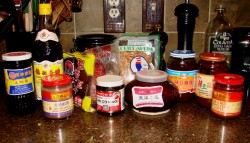
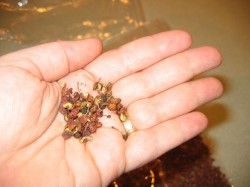
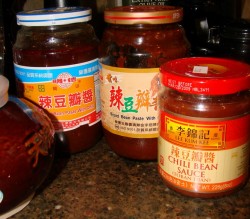
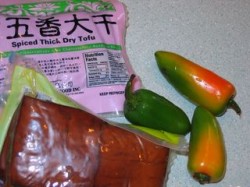
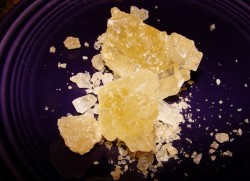
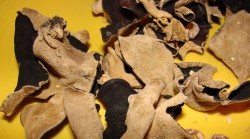
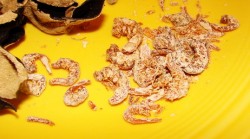


This is very cool. Thanks for the intriguing list!
Comment by Laura — July 25, 2007 #
That’s an excellent list. I used to be of the opinion that Asian people cooked their food so much better than I could so we ate Asian food out. I am now experimenting more and more with Asian flavours and appreciate you info
Thanks
Comment by Gilli — July 25, 2007 #
I store all my bulk spices by sealing them with my food saver. Is that good enough or should I put them in the freezer as well?
Comment by Grace Dykstra — July 25, 2007 #
What an amazing post! You should write a cookbook – Chinese Cooking for Americans (or WTTE). I live in an area with a huge Chinese population and I’m very experimental but you have taught me a TON of things I didn’t know. However, I’m with Zak and Morganna on the fermented tofu but then, I don’t like strong cheeses either. I had some aged goat cheese once in France and I swear that that damn goat was not only old, she had never been washed in her life. It put me off stinky cheese or stinky condiments.
Comment by Nancy — July 26, 2007 #
thanks for this series of posts
In my library I keep various Chinese ingredient encyclopedias and cookbooks and am happy to see my apprehensions of a basic Chinese pantry echoed here
I recently moved with my partner to Indianapolis and am excitedly seeking out ethnic potables provenders
Recently, I found a Taiwanese market and was enthusiastically-tailed around the small store by the owner who was very willing to help and extremely apologetic when they came up short on a handful of items on my “list.”
She left the impression that they don’t see many Anglos in the store. Not surprising, really, unfortunately.
anyway, I was heartened and also saddened to see my beloved Ming Teh Food Industries bottles in your photo…I had to chuck a bunch of my provisions pre-move…and the Taiwanese market doesn’t carry them…
I did find Pearl River Bridge products and Squid brand nam pla…so, that’s all good
and…there are other Asian markets in Indy I’ve yet to explore
I can’t wait 🙂
Comment by Christopher Gordon — July 26, 2007 #
Laura, you are welcome.
Gilli, I hope that this list and my first list will both be of great help to you in the future. If you ever have any questions, just email me.
Grace–I think that if you vacuum seal your spices and keep them in a cool, dark place, they will be fine. The freezer is just for folks like me who don’t have the ability to do airtight sealing!
Nancy–I have been thinking of writing a Chinese cookbook that is heavy on technique and understanding ingredients, with the aim of teaching readers how to cook Chinese on their own without needing recipes. That is part of why I write these posts the way I do–as practice!
As for the stinky tofu–well, I love stinky cheese, too. I also like “thousand year old eggs, and have liked them from the first time I tasted them. Which is odd, apparently–usually they are an acquired taste.
Not everyone has to love everything. There are plenty of goodies in the world for us all to have different favorites. I am just lucky enough to love lots of stuff!
Christopher, let me know if you cannot find the Ming Teh, and I will see if I can find you a place you can order them from the web. But I am sure you will find them somewhere.
Also, you can always print out a picture of what you want from my site, and take it with you–and if the shop doesn’t carry it, they may order it for you, especially if you are a regular customer.
The lady who owns the shop here in Athens will do that for myself and some of my friends.
Comment by Barbara — July 27, 2007 #
thanks very much
We’re *still* unpacking so I haven’t had time to make a truly in-depth search of the ethnic markets around town.
the printout idea is such a no-brainer…can’t believe it didn’t occur to me before…great idea!
I happened upon a West African market last week which is good to have around if I start seriously exploring those cuisines…and the proprietor there was also really cool
I could be completely off-base, but I don’t think Indianapolis is all that exploratory when it comes to Anglos homecooking ethnic cuisines…at least in these past two shopping instances I’ve been welcomed warmly after it first being ascertained that I hadn’t stumbled in by mistake!
Comment by Christopher Gordon — July 27, 2007 #
You just reminded me of a fav home dish my mom makes: Zha cai + marinated chicken pieces + lap cheong slices – steam.
YUM.
Comment by Jaden — July 29, 2007 #
Hi Barbara,
thanx for a wonderful entry, it was very educational. I also blog about food, the spicy kind. i recently bought DOU FU RU, or fermented ‘stinky’ tofu in chile sauce. It comes in a earthen jar, almost like the one at your pic. WHAT DO I DO WITH IT????
Caould you share some recipes or ideas, please?
Comment by Zlamushka — August 7, 2007 #
Zlamushka–you can use the stinky tofu as a condiment, to spice up plain steamed rice or in scrambled eggs. It can also be added to a stir fry to flavor it the way that the fermented black beans or pickled vegetables are added.
It is also good chopped up and put into fried rice–in fact, I really like it that way, myself. I also like it with eggs, too.
Comment by Barbara — August 9, 2007 #
Barbara,
thanks for the ideas. I have googled several recipes and my most favorite so far is to fry a few tablespoons of dou fu ru with some garlic, add fresh green leafy veggie, a splach of water and cook until soft.
Comment by Zlamushka — April 19, 2008 #
Hmm, I just bought a jar of Ming Teh broad bean paste with chili, and it’s got the blue and orange label. Does that mean it’s old?
Comment by KCinDC — May 26, 2008 #
Hmm… Both the Ming Teh and the Lee Kum Kee brand chili bean pastes contain wheat. Do you know of any brands which do not contain wheat/gluten, or a good substitution for chili bean paste?
Comment by Jonathan — July 16, 2011 #
Jonathan,
Miso is fermented soy bean paste made with either rice or barley. As I understand it, rice is safe for those with gluten issues to eat, so try red or Aka Miso mixed with chili garlic sauce to substitute for Chinese chili bean paste. It will not be perfect, but it will taste close.
Comment by Barbara — July 17, 2011 #
Barbara, I love you! I really do. You have NO idea how I crave some Chinese dishes and Lord knows how many times I have tried to replicate them at home without success. I have no trouble recognizing some ingredients, but my biggest issue is the base or some sauce ingredients. I ask in the restaurants, they don’t tell me, I stop people on Asian grocery store iles :)) nobody can tell me anything. This post along with the first one on staple Chinese ingredients gave me more info than I was able to gather in years of error and trial. Thank you so much for taking the time to enlighten us “ingredient-challenged-chinese-food-aficionados” 🙂
Comment by Marianne — August 2, 2012 #
I’m glad to help, Marianne….always. If you have specific questions, you can always email me.
Comment by Barbara — August 2, 2012 #